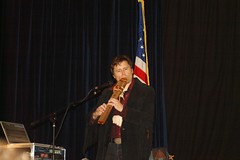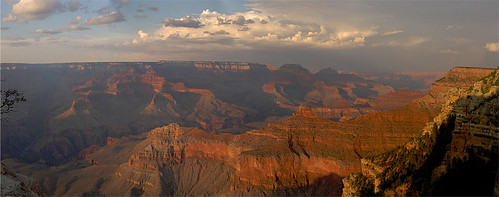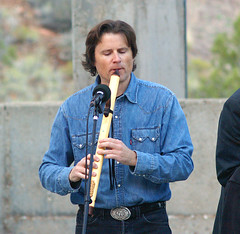
Postings by Scott August, about the Native American style flute,
the Pueblo/Anasazi flute, Xiao and the Southwest
Sunday, December 10, 2006
Sunday, November 05, 2006
Recording Your Own Flute Music
One of the questions I seem to get more than any other is from people wanting to know how to record their own flute playing. As I use fairly expensive equipment and software for my recordings I'm never sure how to answer this as I assume that most people don't intend to spend a lot of money.
So I called my friend Hal Stevens at West LA Music and picked his brain a little. Hal gave me a few options for people wanting to put together a small inexpensive set-up to record themselves and we'll look at two different options in this post. At the bottom you'll find contact info for Hal and I highly recommend you contact him before buying anything.
WHAT IT ALL MEANS:
Before we start let's talk about a some of the components and what they do.
Click here to read all of Recording Your Own Flute Music
So I called my friend Hal Stevens at West LA Music and picked his brain a little. Hal gave me a few options for people wanting to put together a small inexpensive set-up to record themselves and we'll look at two different options in this post. At the bottom you'll find contact info for Hal and I highly recommend you contact him before buying anything.
WHAT IT ALL MEANS:
Before we start let's talk about a some of the components and what they do.
Microphones: A Mic converts sound waves to electronic impulses. The better the Mic the better the conversion, e.g. the better the sound recorded.
Audio Interfaces: A audio interface converts the electronic impulses from a Mic into the 1s and 0s of digital code. The better the audio interface the better the conversion into digital code. Audio interfaces also convert the digital code back to electrical impulses that go to your Monitors (speakers). Again the better the audio interface the better the sound delivered to your speaks and thus your and your listeners ears.
Audio interfaces are also known by the name Digital I/O.
Click here to read all of Recording Your Own Flute Music
Wednesday, October 04, 2006
Twilight Journey
During the day the colors of the canyon country are washed out, lossing their rich hues and becoming pale and dull. But during sunrise and sunset, when shadows are long and the rays from the sun are traveling though more of the earth's atmosphere the colors of the desert bursts to life. Reds ignite like fire, the blue of the sky turns a rich turquoise and sandstone cliffs glows the spectrum between white, pink and gold.
I find myself waiting for these this special time of day. Waitingat the edge of some vast canyon or hurrying in my truck to some spot I know will perfectly catch the light. Camera ready. I call these Twilight Journeys.
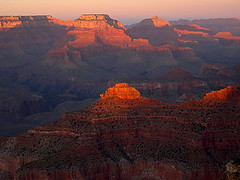 One place that never fails no matter how many times I've seen them are the sunsets at Grand Canyon. I'm always amazed. Most people choose watch the sun, itself, set over the horizon. Something I've always felt I can do at home. I prefer to face away from the sun and watch the colors of the canyon cliffs come to life. For only at the canyon can you experience the fiery reds, glistening golds and shimmering sand colors that make help make the canyon grand.
One place that never fails no matter how many times I've seen them are the sunsets at Grand Canyon. I'm always amazed. Most people choose watch the sun, itself, set over the horizon. Something I've always felt I can do at home. I prefer to face away from the sun and watch the colors of the canyon cliffs come to life. For only at the canyon can you experience the fiery reds, glistening golds and shimmering sand colors that make help make the canyon grand.
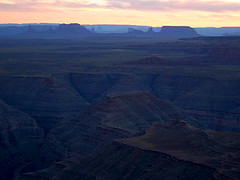 Another place that is almost always perfect is the southern edge of Cedar Mesa, the place where Cedar Mesa Music gets it's name. Rising 1,100' above the Goosenecks of the San Juan river, Valley of the Gods and Mexican Hat, on a clear day from any of the vantage points you can see from Ute Mountain in southeastern Colorado to Monument Valley on the Utah-Arizona border.
Another place that is almost always perfect is the southern edge of Cedar Mesa, the place where Cedar Mesa Music gets it's name. Rising 1,100' above the Goosenecks of the San Juan river, Valley of the Gods and Mexican Hat, on a clear day from any of the vantage points you can see from Ute Mountain in southeastern Colorado to Monument Valley on the Utah-Arizona border.
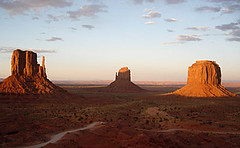 Below Cedar Mesa from the view point at Monument Valley Tribal Park you can get a close up view of the famous Mittens and if you're there during sunset you can see Ute Mountain to the east and the silhouette of Navajo Mountain to the west. Navajo Mountain is also visible at sunset from Cedar Mesa. It is sacred to the Navajos and like all the mountains of the Four Corners a fixed point on the landscape
Below Cedar Mesa from the view point at Monument Valley Tribal Park you can get a close up view of the famous Mittens and if you're there during sunset you can see Ute Mountain to the east and the silhouette of Navajo Mountain to the west. Navajo Mountain is also visible at sunset from Cedar Mesa. It is sacred to the Navajos and like all the mountains of the Four Corners a fixed point on the landscape
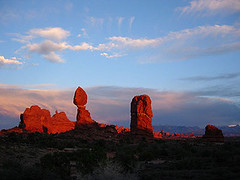 To be honest, there aren't many bad spots to catch the end of day in southern Utah, but one of the best is in Arches National Park. So many elements come together there, vast open spaces, playful arches, balancing rocks and views of snow covered mountain. There are so many places in the park where the line between the last rays of daylight and the first shadows of night is a razor sharp line. As if you could move from day to night in a single step as you watch night take over day and swallow the earth whole.
To be honest, there aren't many bad spots to catch the end of day in southern Utah, but one of the best is in Arches National Park. So many elements come together there, vast open spaces, playful arches, balancing rocks and views of snow covered mountain. There are so many places in the park where the line between the last rays of daylight and the first shadows of night is a razor sharp line. As if you could move from day to night in a single step as you watch night take over day and swallow the earth whole.
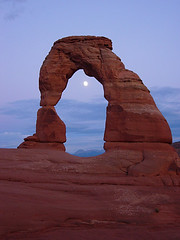 Sunset is also one the most popular time to visit Delicate Arch, the Park's most famous feature. The last time I was there it felt like I was at some ancient temple of stone. As the sun set the arch began to glow gold. Suddenly the moon appeared behind the arch, rising over the La Sal mountains. I climb into the slick sandstone bowl that lies below Delicate Arch, risking a nasty fall, and got a shot of the moon shinning through the arch hole. Nature's Stonehenge.
Sunset is also one the most popular time to visit Delicate Arch, the Park's most famous feature. The last time I was there it felt like I was at some ancient temple of stone. As the sun set the arch began to glow gold. Suddenly the moon appeared behind the arch, rising over the La Sal mountains. I climb into the slick sandstone bowl that lies below Delicate Arch, risking a nasty fall, and got a shot of the moon shinning through the arch hole. Nature's Stonehenge.
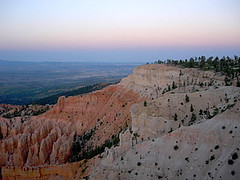 Views also abound at Bryce Canyon National Park. The elevation at Sunset Point is 8,000' and the canyon, really a series of amphitheaters, tumbles down to the Paria valley 1,000' below. Once again Navajo mountain is visible, if just barely. This time it lies to the east.
Views also abound at Bryce Canyon National Park. The elevation at Sunset Point is 8,000' and the canyon, really a series of amphitheaters, tumbles down to the Paria valley 1,000' below. Once again Navajo mountain is visible, if just barely. This time it lies to the east.
From Bryce bands of color are seen in the sky to the east during the last minutes of daylight. They become lighter as they climb higher in to the twilight sky. These bands are the thin layers of the earth's atmosphere made visible, and are the last breath of daylight.
These are but a few of the locations that I love so much during this special time of day. Others happen without warning or expectation. All of them Twilight Journeys.
TWILIGHT JOURNEY is the latest free MP3 download available to memeber of my e-Mailing List. It features a Pat Haran E bass flute made of curly Port Orford Cedar with accents of Redwood and Padauk. Orignially recorded as an improvisation during my concert the Nixon Library in July of this year. Later in my studio I added textures, loops and piano to add to the mystery and emotion of the piece.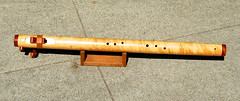 To listen or download it follow the link below. Then sit back and let your mind and imagination drift.
To listen or download it follow the link below. Then sit back and let your mind and imagination drift.
In Harmony
-Scott August
Join Scott August's free e-Mailing List to listen to TWILIGHT JOURNEY
All © Cedar Mesa Music. All rights reserved.
I find myself waiting for these this special time of day. Waitingat the edge of some vast canyon or hurrying in my truck to some spot I know will perfectly catch the light. Camera ready. I call these Twilight Journeys.
 One place that never fails no matter how many times I've seen them are the sunsets at Grand Canyon. I'm always amazed. Most people choose watch the sun, itself, set over the horizon. Something I've always felt I can do at home. I prefer to face away from the sun and watch the colors of the canyon cliffs come to life. For only at the canyon can you experience the fiery reds, glistening golds and shimmering sand colors that make help make the canyon grand.
One place that never fails no matter how many times I've seen them are the sunsets at Grand Canyon. I'm always amazed. Most people choose watch the sun, itself, set over the horizon. Something I've always felt I can do at home. I prefer to face away from the sun and watch the colors of the canyon cliffs come to life. For only at the canyon can you experience the fiery reds, glistening golds and shimmering sand colors that make help make the canyon grand. Another place that is almost always perfect is the southern edge of Cedar Mesa, the place where Cedar Mesa Music gets it's name. Rising 1,100' above the Goosenecks of the San Juan river, Valley of the Gods and Mexican Hat, on a clear day from any of the vantage points you can see from Ute Mountain in southeastern Colorado to Monument Valley on the Utah-Arizona border.
Another place that is almost always perfect is the southern edge of Cedar Mesa, the place where Cedar Mesa Music gets it's name. Rising 1,100' above the Goosenecks of the San Juan river, Valley of the Gods and Mexican Hat, on a clear day from any of the vantage points you can see from Ute Mountain in southeastern Colorado to Monument Valley on the Utah-Arizona border. Below Cedar Mesa from the view point at Monument Valley Tribal Park you can get a close up view of the famous Mittens and if you're there during sunset you can see Ute Mountain to the east and the silhouette of Navajo Mountain to the west. Navajo Mountain is also visible at sunset from Cedar Mesa. It is sacred to the Navajos and like all the mountains of the Four Corners a fixed point on the landscape
Below Cedar Mesa from the view point at Monument Valley Tribal Park you can get a close up view of the famous Mittens and if you're there during sunset you can see Ute Mountain to the east and the silhouette of Navajo Mountain to the west. Navajo Mountain is also visible at sunset from Cedar Mesa. It is sacred to the Navajos and like all the mountains of the Four Corners a fixed point on the landscape  To be honest, there aren't many bad spots to catch the end of day in southern Utah, but one of the best is in Arches National Park. So many elements come together there, vast open spaces, playful arches, balancing rocks and views of snow covered mountain. There are so many places in the park where the line between the last rays of daylight and the first shadows of night is a razor sharp line. As if you could move from day to night in a single step as you watch night take over day and swallow the earth whole.
To be honest, there aren't many bad spots to catch the end of day in southern Utah, but one of the best is in Arches National Park. So many elements come together there, vast open spaces, playful arches, balancing rocks and views of snow covered mountain. There are so many places in the park where the line between the last rays of daylight and the first shadows of night is a razor sharp line. As if you could move from day to night in a single step as you watch night take over day and swallow the earth whole. Sunset is also one the most popular time to visit Delicate Arch, the Park's most famous feature. The last time I was there it felt like I was at some ancient temple of stone. As the sun set the arch began to glow gold. Suddenly the moon appeared behind the arch, rising over the La Sal mountains. I climb into the slick sandstone bowl that lies below Delicate Arch, risking a nasty fall, and got a shot of the moon shinning through the arch hole. Nature's Stonehenge.
Sunset is also one the most popular time to visit Delicate Arch, the Park's most famous feature. The last time I was there it felt like I was at some ancient temple of stone. As the sun set the arch began to glow gold. Suddenly the moon appeared behind the arch, rising over the La Sal mountains. I climb into the slick sandstone bowl that lies below Delicate Arch, risking a nasty fall, and got a shot of the moon shinning through the arch hole. Nature's Stonehenge. Views also abound at Bryce Canyon National Park. The elevation at Sunset Point is 8,000' and the canyon, really a series of amphitheaters, tumbles down to the Paria valley 1,000' below. Once again Navajo mountain is visible, if just barely. This time it lies to the east.
Views also abound at Bryce Canyon National Park. The elevation at Sunset Point is 8,000' and the canyon, really a series of amphitheaters, tumbles down to the Paria valley 1,000' below. Once again Navajo mountain is visible, if just barely. This time it lies to the east.From Bryce bands of color are seen in the sky to the east during the last minutes of daylight. They become lighter as they climb higher in to the twilight sky. These bands are the thin layers of the earth's atmosphere made visible, and are the last breath of daylight.
These are but a few of the locations that I love so much during this special time of day. Others happen without warning or expectation. All of them Twilight Journeys.
TWILIGHT JOURNEY is the latest free MP3 download available to memeber of my e-Mailing List. It features a Pat Haran E bass flute made of curly Port Orford Cedar with accents of Redwood and Padauk. Orignially recorded as an improvisation during my concert the Nixon Library in July of this year. Later in my studio I added textures, loops and piano to add to the mystery and emotion of the piece.
 To listen or download it follow the link below. Then sit back and let your mind and imagination drift.
To listen or download it follow the link below. Then sit back and let your mind and imagination drift. In Harmony
-Scott August
Join Scott August's free e-Mailing List to listen to TWILIGHT JOURNEY
All © Cedar Mesa Music. All rights reserved.
Tuesday, September 12, 2006
New Fire wins Indian Sumer Music Award!
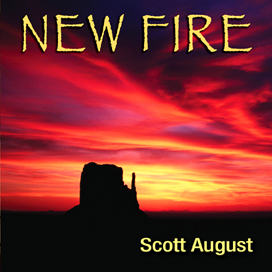
New Fire has won a Indian Summer Music Award (ISMA) in the Native Spirit category. The awards were part of the Indian Summer Festival which celebrated their 20th anniversary September 8, 9 and 10, 2006 at Henry Maier Festival Park on Milwaukee’s beautiful lakefront.
The winners were picked by judges who are professionals in the music and entertainment industries. All judging is conducted independently of the ISMA Committee and consists of a two phase process to determine the winners in each category.
Fore more details on the visit their web site. Indian Summer Festival .
Saturday, September 09, 2006
Tuesday, August 15, 2006
Playing/Composing from the Heart -part 2
Whenever I teach a song writing class for Native American flute players one of the biggest frustrations I hear from my students is that they have a real difficult time not ending everything on the bottom note of the flute. This is a common complaint and in this article we'll give you some ideas about how to deal with this.
Untimely many songs do end on the bottom note, the trick is to delay this so that when you finally do it land on the bottom note it will have a stronger sense of closure. Delaying an ending on the root note sets up some nice tension in your musical ideas and gives your songs a sense of progression and resolution. Like taking a little musical journey and then returning safely home.
Here is what we're going to look at:
As I teach in my classes, one of the best ways to Play from the Heart is to really understand the NAF pentatonic minor scale and the implied harmonies that can be found in the notes. Each note in the scale has it's own weight, or gravity, relative to the other notes in the scale. Those with less weight tend to move to those with more. Knowing and understanding these relationships will allow you to exploit this natural phenomenon and will help give your tunes an implied harmonic motion. Normally an instrument that can produce chords plays harmonies, but you can create the illusion of harmony by the notes you choose for your melodies, especially at the ends of phrases.
Untimely many songs do end on the bottom note, the trick is to delay this so that when you finally do it land on the bottom note it will have a stronger sense of closure. Delaying an ending on the root note sets up some nice tension in your musical ideas and gives your songs a sense of progression and resolution. Like taking a little musical journey and then returning safely home.
Here is what we're going to look at:
Why All Notes Lead to the Root
The Weight and Gravity of the Notes of the NAF Scale
A Look at Each Note
How to Apply This: Some Simple Exersises
As I teach in my classes, one of the best ways to Play from the Heart is to really understand the NAF pentatonic minor scale and the implied harmonies that can be found in the notes. Each note in the scale has it's own weight, or gravity, relative to the other notes in the scale. Those with less weight tend to move to those with more. Knowing and understanding these relationships will allow you to exploit this natural phenomenon and will help give your tunes an implied harmonic motion. Normally an instrument that can produce chords plays harmonies, but you can create the illusion of harmony by the notes you choose for your melodies, especially at the ends of phrases.
Click here to read all of PLAYING FROM THE HEART, part 2.
Wednesday, August 02, 2006
Moki Dugway

Another panorama from the top of the Moki Dugway. You can see all the way to Colorado, on the left, to Arizona on the right. Sleeping Ute Mountain, Valley of the Gods, Mexican Hat, the Goosenecks of the San Juan river, Monument Valley and the southern tip of Cedar Mesa can be see from here. ...of course we're on Cedar Mesa, from which Cedar Mesa Music gets it's name.
Comb Ridge
Sunday, July 30, 2006
Wednesday, June 28, 2006
Playing from the Heart -part 1
One of the beauties of the Native American flute is that it is within reach of people who have no musical background at all. The majority of Native American flute players have no formal musical training. I say formal because I believe that most human beings innately have music inside them. We respond to rhythms, melodies, and harmonies from birth, or even while still in the womb. It is all part of being human.
However, I meet many NAF players, or people that are thinking about becoming one, that worry they don'’t have any musical training and therefore they lack something when it comes to making music. In my opinion, nothing could be further from the truth. I’m not saying that musical training doesn't help, but a lack of it is no reason to avoid playing the Native American flute. Music is a basic expression of human emotional. If you are drawn to music that desire for expression is already stirring within you. Besides, there are plenty of people with little or no musical musical training that are world-famous musicians. Many rock, blues and pop musicians have very little musical training and yet we hum their tunes and buy their recording all the time. They must have something in their hearts...
The music is already inside you, you just need to get it out.
WHAT IS PLAYING FROM THE HEART?
Playing from the Heart is what the Native American flute world calls improvisation. To improvise is to make something up while performing...
To read all of Playing from the Heart, part 1 click here.
However, I meet many NAF players, or people that are thinking about becoming one, that worry they don'’t have any musical training and therefore they lack something when it comes to making music. In my opinion, nothing could be further from the truth. I’m not saying that musical training doesn't help, but a lack of it is no reason to avoid playing the Native American flute. Music is a basic expression of human emotional. If you are drawn to music that desire for expression is already stirring within you. Besides, there are plenty of people with little or no musical musical training that are world-famous musicians. Many rock, blues and pop musicians have very little musical training and yet we hum their tunes and buy their recording all the time. They must have something in their hearts...
The music is already inside you, you just need to get it out.
WHAT IS PLAYING FROM THE HEART?
Playing from the Heart is what the Native American flute world calls improvisation. To improvise is to make something up while performing...
To read all of Playing from the Heart, part 1 click here.
Wednesday, June 14, 2006
Strengthening your fingers
In the last article we looked at playing your first Native American flute scale. It would seem natural that at this point you would ask the question "Now what?". There are a couple things that would be good to consider. Strengthening your fingers is one of them. The other is to begin "Playing from the Heart" which is the NAF word for improvisation, or just "noodling" around on your NAF and playing whatever pops into your head. We'll look at "Playing from the Heart" later, for now let's look at a couple easy ways to strengthen your fingers.
WHERE WE’RE HEADED
The point of this article is to start you on the path to freeing your mind from having to think about your fingers. The less you have to concentrate on your fingers the more you can focus on playing your music, and the music's what it's all about. To do that we're going to look at some very basic things you can do to prepare your fingers to move effortlessly, allowing you to play more freely.
A COUPLE THOUGHTS
The Brain Connection
The first thing to keep in mind is that you don't need strong fingers in the sense of muscle strength. You don’t need to do finger pushups. What is meant by strength here is mostly improving your coordination, which is handled by the brain. So what you're really doing is training your brain and it's messages to and from your fingers.
Repetition2
The second thing to consider is that like anything you do, and I mean anything, the more you do it the better you get. Repetition also multiplies on itself non linearly. I like to point out to the people that attend my NAF classes that if you were to tie your shoelaces every day of your life, that by the time you were 35 years old you would have tied them 12,775 times! Odds are you've gotten pretty good at it. The exercises below work the same way.
REVIEW
Before we begin let's review the set up of the NAF. Remember that each hole has a number. We will also call the finger that covers any hole by the same number. So hole #1 is covered by finger #1.
Fig. 1 The finger holes of a six holed NAF
SOME SIMPLE EXERCISES
Here are some simple ideas that you can use everyday to warm up and strengthen you brain – finger connection.
READ THE REST IN SCOTT AUGUST'S NEW BOOK The Complete Guide to the Native American Style Flute
Learn More
Get Your Copy Today!
© 2011 Cedar Mesa Music. All rights reserved.
WHERE WE’RE HEADED
The point of this article is to start you on the path to freeing your mind from having to think about your fingers. The less you have to concentrate on your fingers the more you can focus on playing your music, and the music's what it's all about. To do that we're going to look at some very basic things you can do to prepare your fingers to move effortlessly, allowing you to play more freely.
A COUPLE THOUGHTS
The Brain Connection
The first thing to keep in mind is that you don't need strong fingers in the sense of muscle strength. You don’t need to do finger pushups. What is meant by strength here is mostly improving your coordination, which is handled by the brain. So what you're really doing is training your brain and it's messages to and from your fingers.
Repetition2
The second thing to consider is that like anything you do, and I mean anything, the more you do it the better you get. Repetition also multiplies on itself non linearly. I like to point out to the people that attend my NAF classes that if you were to tie your shoelaces every day of your life, that by the time you were 35 years old you would have tied them 12,775 times! Odds are you've gotten pretty good at it. The exercises below work the same way.
- TIP: Practice makes better
REVIEW
Before we begin let's review the set up of the NAF. Remember that each hole has a number. We will also call the finger that covers any hole by the same number. So hole #1 is covered by finger #1.
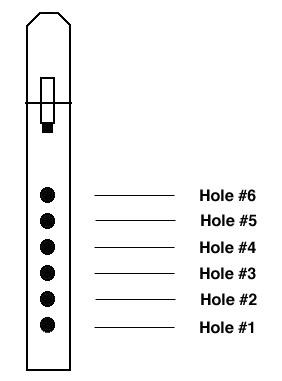
Fig. 1 The finger holes of a six holed NAF
SOME SIMPLE EXERCISES
Here are some simple ideas that you can use everyday to warm up and strengthen you brain – finger connection.
READ THE REST IN SCOTT AUGUST'S NEW BOOK The Complete Guide to the Native American Style Flute

Learn More
Get Your Copy Today!
© 2011 Cedar Mesa Music. All rights reserved.
Saturday, June 03, 2006
Temple of the Sun: solo intro
Here is a video of the solo intro to Temple of the Sun from New Fire.
To Play, click on the play "button" on the lower left hand side of the image.
This was taken by my friend Keith Stanford last fall.
You can read more about this flute here.
Leave a comment here or email me at
blog@cedarmesa.com
Friday, June 02, 2006
Playing your first scale on a Native American flute
NATIVE AMERICAN FLUTE PLAYING BASICS.
In this article we will cover playing your first Native American flute scale and begin to familiarize yourself with the basic fingering and notes of this wonderful instrument.
There are many books and videos about how to get started on the Native American flute. Odds are when you purchased your new NAF you may have got one from the maker. But just in case you don’t have one, you lost it or you need a quick, easy refresher we’ll quickly go over the basics in this article, along with some handy playing tips that you can use all the time.
EASY TO PLAY.
The Native American flute is a fipple flute. There are many fipple flutes around the world. European recorders, tin whistles and penny whistles and ocarinas to name a few. Fipple flutes, unlike silver flutes, pan-pipes and other wind instruments do not require you to produce the sound with the shape of your mouth. This makes playing a musical note very easy. You just put your lips to the mouthpiece and blow. In fact you can do it without covering any of the finger holes.
Go ahead and try it now. Leave open all the holes and just blow into the mouthpiece.
HOW TO HOLD YOUR NAF
Hold your flute with the first three fingers from each hand and both your thumbs. The flute should be at about 45˚ from your body. Stand up straight, hunching your shoulders will hinder your breathing. The holes are covered with the first three fingers from each hand. Most people cover the top three holes with their left hand and the bottom three holes with their right hand. However, you may switch hands if you feel that is more comfortable. Use the fleshy pads of your finger-tips, not the tips themselves. This helps prevent air from leaking past your fingers.
Let’s assign numbers to the finger holes of the NAF, starting from the bottom and working our way up to the top of the flute. The hole closest to the bottom of the flute is Hole #1, the next one up is Hole #2, then hole #3, and so one until the last one hole which is hole #6. This way of numbering conforms to the basic scale of the flute. (fig. 1)
READ THE REST IN SCOTT AUGUST' NEW BOOK:
The Complete Guide to the Native American Style Flute

Get your copy today at Cedar Mesa Music!
© 2011 Cedar Mesa Music. All rights reserved.
In this article we will cover playing your first Native American flute scale and begin to familiarize yourself with the basic fingering and notes of this wonderful instrument.
There are many books and videos about how to get started on the Native American flute. Odds are when you purchased your new NAF you may have got one from the maker. But just in case you don’t have one, you lost it or you need a quick, easy refresher we’ll quickly go over the basics in this article, along with some handy playing tips that you can use all the time.
EASY TO PLAY.
The Native American flute is a fipple flute. There are many fipple flutes around the world. European recorders, tin whistles and penny whistles and ocarinas to name a few. Fipple flutes, unlike silver flutes, pan-pipes and other wind instruments do not require you to produce the sound with the shape of your mouth. This makes playing a musical note very easy. You just put your lips to the mouthpiece and blow. In fact you can do it without covering any of the finger holes.
Go ahead and try it now. Leave open all the holes and just blow into the mouthpiece.
HOW TO HOLD YOUR NAF
Hold your flute with the first three fingers from each hand and both your thumbs. The flute should be at about 45˚ from your body. Stand up straight, hunching your shoulders will hinder your breathing. The holes are covered with the first three fingers from each hand. Most people cover the top three holes with their left hand and the bottom three holes with their right hand. However, you may switch hands if you feel that is more comfortable. Use the fleshy pads of your finger-tips, not the tips themselves. This helps prevent air from leaking past your fingers.
Let’s assign numbers to the finger holes of the NAF, starting from the bottom and working our way up to the top of the flute. The hole closest to the bottom of the flute is Hole #1, the next one up is Hole #2, then hole #3, and so one until the last one hole which is hole #6. This way of numbering conforms to the basic scale of the flute. (fig. 1)

READ THE REST IN SCOTT AUGUST' NEW BOOK:
The Complete Guide to the Native American Style Flute

Get your copy today at Cedar Mesa Music!
© 2011 Cedar Mesa Music. All rights reserved.
Saturday, May 20, 2006
How to care for your Native American Flute
So you bought your first flute and have started play it. Congratulations! I’m sure the question “What do I need to do to take care of it?” has crossed your mind. A Native American flute is a musical instrument and like all instruments needs special care. As a woodwind instrument your NAF has some extra needs that don't come with guitars, pianos and other non-woodwinds.
Moisture
The biggest problem that you will encounter is moisture. As a wind instrument every time you play your NAF you force moisture from your breath inside the flute. As this moisture builds up in the space between the block and the flute, called the “flue”, it will eventually prevent the flute from playing and choke off the airflow that produces the sound. This is called “watering out” and is the main problem most NAF players encounter. Watering out is a product of a couple factors: the temperature of your breath and the temperature of your flute.
The temperature of your breath is close to your body temperature or 98.6˚. The flute, however, is close to the ambient temperature of air around it, usually lower than 98˚. This also applies to humidity. The humidity of your breath is usually higher than the humidity of the air around the flute, unless you like to play in the shower.
As you play, you blow hot, moist, humid air into your flute. This moisture is partially absorbed into the wood causing the wood to swell. The remainder is deposited as small beads of moisture in the slow-air-chamber, also called the wind chamber, and the flue.
Under normal circumstances these beads of moisture will clump together becoming larger and larger in the flue until they choke off the flow of air. At first your flute will begin to lose it’s tone and sound breathy and wispy, then it will stop producing a sound altogether.
As for the swelling of the wood, if taken to extreme, will cause the seam to break, usually near the mouthpiece. Although less common, the swelling can cause a split in the wood if there is a defect in the wood itself.
How to Manage Watering Out
READ THE REST IN SCOTT AUGUST'S NEW BOOK The Complete Guide to the Native American Style Flute
Learn More Get Your Copy Today!
© 2011 Cedar Mesa Music. All rights reserved.
Moisture
The biggest problem that you will encounter is moisture. As a wind instrument every time you play your NAF you force moisture from your breath inside the flute. As this moisture builds up in the space between the block and the flute, called the “flue”, it will eventually prevent the flute from playing and choke off the airflow that produces the sound. This is called “watering out” and is the main problem most NAF players encounter. Watering out is a product of a couple factors: the temperature of your breath and the temperature of your flute.
The temperature of your breath is close to your body temperature or 98.6˚. The flute, however, is close to the ambient temperature of air around it, usually lower than 98˚. This also applies to humidity. The humidity of your breath is usually higher than the humidity of the air around the flute, unless you like to play in the shower.
As you play, you blow hot, moist, humid air into your flute. This moisture is partially absorbed into the wood causing the wood to swell. The remainder is deposited as small beads of moisture in the slow-air-chamber, also called the wind chamber, and the flue.
Under normal circumstances these beads of moisture will clump together becoming larger and larger in the flue until they choke off the flow of air. At first your flute will begin to lose it’s tone and sound breathy and wispy, then it will stop producing a sound altogether.
As for the swelling of the wood, if taken to extreme, will cause the seam to break, usually near the mouthpiece. Although less common, the swelling can cause a split in the wood if there is a defect in the wood itself.
How to Manage Watering Out
READ THE REST IN SCOTT AUGUST'S NEW BOOK The Complete Guide to the Native American Style Flute

Learn More Get Your Copy Today!
© 2011 Cedar Mesa Music. All rights reserved.
Thursday, May 04, 2006
How to buy a Native American flute: Part 2
In Part 1 of How to Buy a Native American flute we looked at several different factors including:
For beginning flute players the most important thing to consider, other than the sound, is the width of the finger spacing of the holes on the flute. People with smaller hands, or those who have never played a musical instrument before, are not used to the stretch that comes with the bigger, lower pitched flutes. Starting with a smaller, higher pitched flute is like doing warm ups before exercising. It will help a beginner get used to playing a NAF without having to worry about a big stretch right away.
A flute in the key of A is a good way to start for people with smaller hands.
If your hands are bigger or if you've played a musical instrument before, the finger spacing will not be as big a consideration. I've found that people with experience playing other wind instruments like clarinet, recorder or a silver flute have no problem with the finger spacing. Pianists also do well. If you've played other instruments before, or you have large hands, you could easily start with a flute in the key of G or F#.
Of course even if you never played an instrument or your hands are smaller you could still start with a G or F# flute. Just try not to over do it and strain a muscle in your hands. Once you've gotten used to the stretch of these the larger flutes you'll do just fine. Most flutes below F# are harder for all beginners to play and I generally don't recommend them for that reason. But there are exceptions and that lead us to our next subject.
READ THE REST IN SCOTT AUGUST'S NEW BOOK
The Complete Guide to the Native American Style Flute
Learn More
Get Your Copy Today!
© 2011 Cedar Mesa Music. All rights reserved.
- Quality of Workmanship
- Quality of Sound
- Tuning
- Fingering
- Ease of Playing
- Finger spacing
- Flute length and bore size
- Types of Wood
- Finishes
For beginning flute players the most important thing to consider, other than the sound, is the width of the finger spacing of the holes on the flute. People with smaller hands, or those who have never played a musical instrument before, are not used to the stretch that comes with the bigger, lower pitched flutes. Starting with a smaller, higher pitched flute is like doing warm ups before exercising. It will help a beginner get used to playing a NAF without having to worry about a big stretch right away.
A flute in the key of A is a good way to start for people with smaller hands.
If your hands are bigger or if you've played a musical instrument before, the finger spacing will not be as big a consideration. I've found that people with experience playing other wind instruments like clarinet, recorder or a silver flute have no problem with the finger spacing. Pianists also do well. If you've played other instruments before, or you have large hands, you could easily start with a flute in the key of G or F#.
Of course even if you never played an instrument or your hands are smaller you could still start with a G or F# flute. Just try not to over do it and strain a muscle in your hands. Once you've gotten used to the stretch of these the larger flutes you'll do just fine. Most flutes below F# are harder for all beginners to play and I generally don't recommend them for that reason. But there are exceptions and that lead us to our next subject.
READ THE REST IN SCOTT AUGUST'S NEW BOOK
The Complete Guide to the Native American Style Flute

Learn More
Get Your Copy Today!
© 2011 Cedar Mesa Music. All rights reserved.
Friday, April 28, 2006
NEW FIRE nominated for NAMMY award!

New Fire has been nominated for a Native American Music award (NAMMY) in in the Native Heart category. The NAMMY awards are the Grammy's of Native American traditional, contemporary and Native inspired music. It is a great honor to be nominated.
All nominees were voted upon by the national Advisory members of the Native American Music Awards and chosen among the 150 national contemporary and traditional music recordings originally submitted for nomination consideration. Winners of the Eighth Annual Native American Music Awards will be determined through membership print ballots and a national voting campaign open to the general public on the Nammy's website.
Yes, the voting is open to the public, so you too can vote for New Fire. To do so go to www.nammys.com
Once at their web site:
You will need to cast a vote for ALL of the 25 categories (which takes about 10 - 15 minutes). This is great opportunity to listen to some artists that you have probably never heard of. There is some great Native American music which hopefully you will enjoy.
The Award ceremony is scheduled to take place June 8th at the Seminole Hard Rock Live Hotel & Casino in Hollywood, Florida. All tickets are on-sale now and available at Ticketmaster.
I hope you'll vote for New Fire and thank you for your support.
Thursday, April 06, 2006
Flute Class: Native American flute Song Writing Workshop.
I am giving a Song Writing Workshop for Native American flute on May 20th, in Southern California. This workshop will focus on how to take your small ideas and turn them into music for the Native American flute.
Learn the tricks and secrets of the pros!
Learn simple, easy techniques for composing melodies and turning them into songs. You will learn how to make your ideas more focused and tighter. This class will get you started on the road to writing your own Native American flute music!
You will also learn how to compose songs on the spot with easy Playing from the Heart improvisation techniques.
This will be a hands on workshop with a lots of playing. Class members will compose a song in class that will then be recorded for a Listen & Learn analyzes and devlopment session. Everyone will receive a copy of their recorded song on Audio CD that they can share with family and friends.
We will cover:
Writing melodies
Techniques for expanding your small ideas into songs
Playing from the Heart and the Head
How to combine melodies
Critical analysis and development.
Composing a song
Recording your songs
Date & Time:
Saturday, May 20th, 2006
10am - 4pm
Location:
Santa Margarita United Methodist Church
30605 Avenida de Las Flores
Rancho Santa Margarita, CA, 92688
Price:
$90.00 per person. Deadline May 6, 2006
How to Enroll:
To enroll or for more information go to Native American flute Song Writing Workshop on my web site
If you don't have a flute read my How to buy a Native American flute article that tells you everything you need to know to buy a good Native American flute. I am making flutes available at a discount to class members.
Please note: This class will not cover the basics of how to play the Native American flute. This class is not recommended if you've never played before.
Here are some photos from past classes:
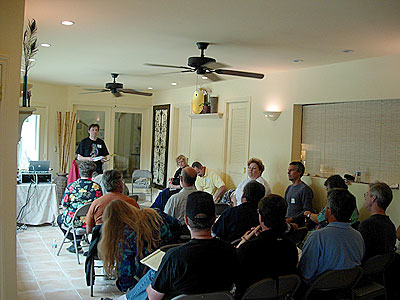
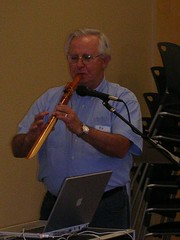
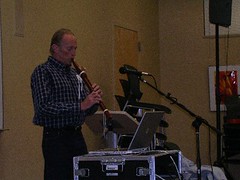
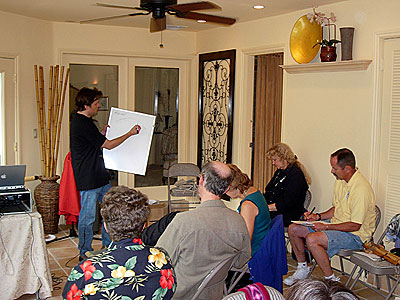
Learn the tricks and secrets of the pros!
Learn simple, easy techniques for composing melodies and turning them into songs. You will learn how to make your ideas more focused and tighter. This class will get you started on the road to writing your own Native American flute music!
You will also learn how to compose songs on the spot with easy Playing from the Heart improvisation techniques.
This will be a hands on workshop with a lots of playing. Class members will compose a song in class that will then be recorded for a Listen & Learn analyzes and devlopment session. Everyone will receive a copy of their recorded song on Audio CD that they can share with family and friends.
We will cover:
Date & Time:
Saturday, May 20th, 2006
10am - 4pm
Location:
Santa Margarita United Methodist Church
30605 Avenida de Las Flores
Rancho Santa Margarita, CA, 92688
Price:
$90.00 per person. Deadline May 6, 2006
How to Enroll:
To enroll or for more information go to Native American flute Song Writing Workshop on my web site
If you don't have a flute read my How to buy a Native American flute article that tells you everything you need to know to buy a good Native American flute. I am making flutes available at a discount to class members.
Please note: This class will not cover the basics of how to play the Native American flute. This class is not recommended if you've never played before.
Here are some photos from past classes:




Wednesday, April 05, 2006
Delicate Arch and a Raven
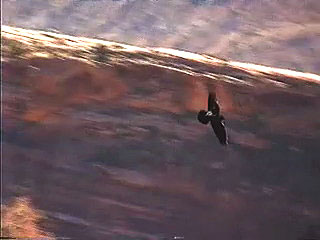
Many years ago, while traveling around the Four Corners I had a chance to visit Arches National Park. This had been a dream of mine ever since I had read Edward's Abbey's Desert Solitaire. His descriptions of the park at that time, the late 50's, and his time there, went deep into my psyche My journey there was almost like a pilgrimage. It was early October, the best time of year in my opinion, to visit southeast Utah. The skies were clear and the days warm, while the nights had a slight chill. Perfect weather for the 1.5 mile slickrock hike to Delicate Arch.
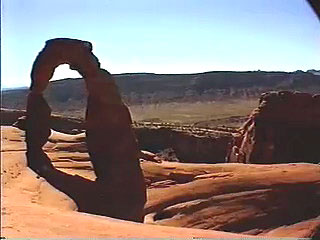
Delicate Arch is one of the most famous landmarks of the Four Corners and Utah. Looking like the the legs of a bow-legged cowboy, it's massive frame balanced on the edge of a slickrock bowl, the arch is nothing like its name. Landscape Arch is more delicate compared to the muscle like shape of Delicate Arch which seems firmly rooted to the ground upon which stands.
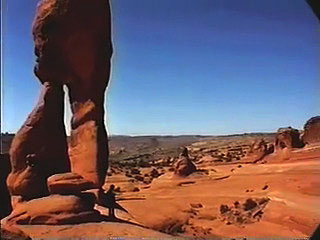
There is also nothing delicate about the number of visitors Arches National Park gets. If you go there don't expect to be alone. Like all the well known sites in the southwest, it is visited to distraction by people from all over the world. It seems the more famous a site becomes, the more people go there just to tick it off their list of places to visit. But if your patient and wait long enough, you might get lucky enough to be there during a lull between the groups of tourists.
Of course you're never alone. For there are always Ravens.
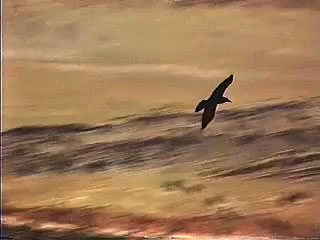
The day I was there, during a lull, when all was quiet, a raven decided to come out to play. He circled the arch and sailed across the bowl next to it, then back to the arch to weave around it like it was some gigantic May Pole.
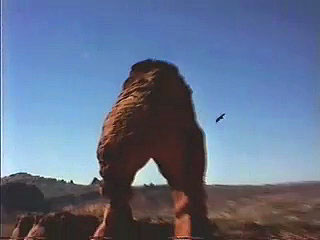
He gronked in pure delete and kept weaving his song lines of flight around the arch. He seemed to be playing some primal raven game with the monolith for pure joy, or perhaps like us, the arch bespoke some deeper connection for him to the landscape of his world. That his circling was a form of pilgrimage.
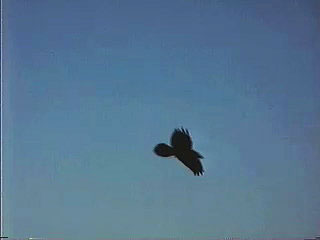
Like most of my encounters with ravens, it was magical and the memory stayed with me. Recently it found expression in the song Ravens & Red-tails on my third recording, New Fire.
I recently went back and captured some of the video I took of his flight and have posted it with a short sample of Ravens & Red-tails.
WATCH THE VIDEO HERE
The song Ravens & Red-tails was recorded with a Scott Loomis Wind's Song flutes in the key of G. This is a very sweet flute and was profiled in an earlier posting. READ ABOUT THE FLUTE
Tuesday, April 04, 2006
Echoes from the Road: Day 12: Corona Arch
The hike to Corona Arch
July 2, 2005. Day 12
Every so often, when I'm out touring, I get the urge to go play. This only happens about ten times a day. I rarely act on this because my schedule is so tight and I'm not supposed to be driving around putting hundreds of miles on my truck to go play -I'm supposed to be working. Once in a while though, I give in to these urges and I take off a little early from an appearance and head for a wild spot where there is more nature and less human.
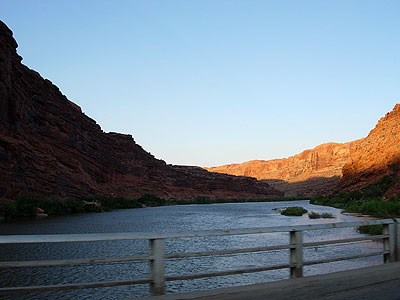
Last June, while in Moab, I did just that. I packed up my flutes and headed north out of town. Just after crossing the Colorado river I turned left onto Potash road.
Potash road.
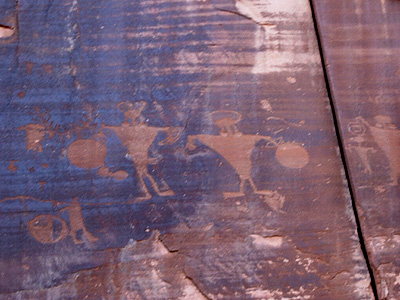
Potash road runs along the north side of the Colorado and passes some very nice petroglyph panels. They're right by the road. So close that if you get out to look at them you have to keep an eye out for cars driving by.
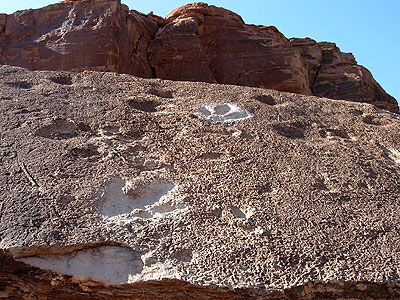
A little farther down from the petroglyph there are some dinosaur footprints. I'd say this guy wore a size 50 shoe.
A couple miles down the road there was a small dirt parking lot and a sign marking the trail head to Corona Arch. I had overheard some people in town saying how nice the arch was, but I wanted to see how far Potash road went, so I kept on driving. Soon, however, the paved road ended at the potash plant and became dirt. I realized that from this point on it continued into Canyonland NP and as it was about 5:00 pm I didn't have enough time for to really explore to road any further .
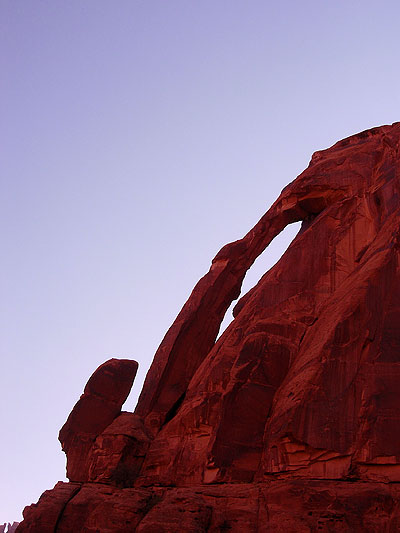
Before heading back I took some photos of a thin arch visible from the side of the road, when the Corona arch popped into my mind again. Ever since I had seen the trail leading off to it I couldn't get rid of the desire to hike out and see it. So when I got back to the trailhead I pulled my truck off into the parking lot, grabbed some water and my camera, and headed out.
The trail to Corona Arch
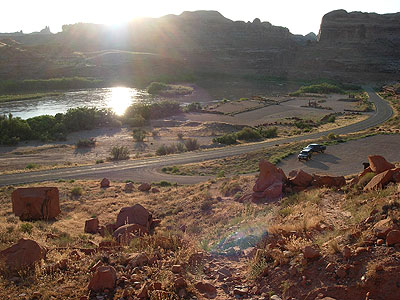
The hike started up a little hill and at the top, I was surprised to find the trail crossing some railroad tracks! The tracks, it turns out, were there for trains that haul potash from plant I'd seen at the end of the road.
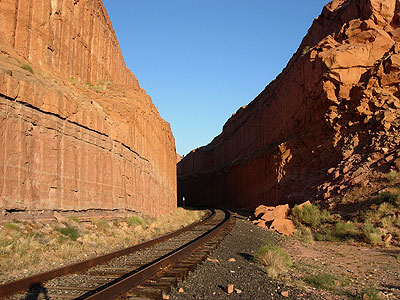
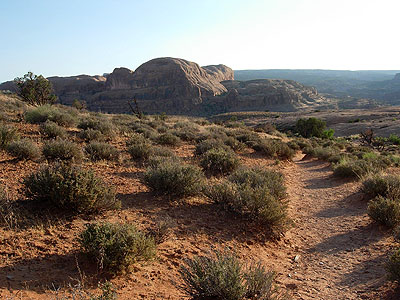
The trail continued up a small side canyon and then came out on a flat area covered with small scrub and a dusty trail. I was completely alone. The trail crested a shallow rise and in the distance some cliffs with large alcoves came into view. For a while the trail kept heading toward them but soon it begin to curve off to the left, where after rounding a bend, I caught my first glimpse of Corona arch about a half mile up a canyon.
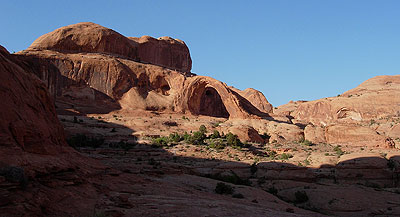
Even at that distance the arch looked huge, as big as any arch I'd ever seen. Picking up my pace I hoped to get up to it before the sun set behind the cliffs. The trail got rougher as it came upon some small ledges that were not passable without rock climbing gear. Luckily someone (the BLM) had run a chain-link hand rail attached to some posts sunk into the stone to aid the average hiker like me scale the rocks. Farther on there was a metal ladder for an even stepper ledge.
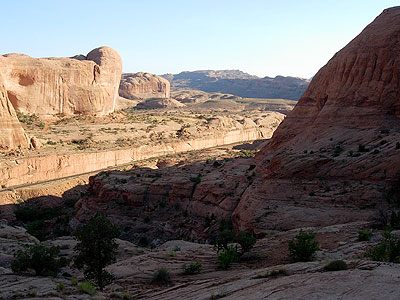
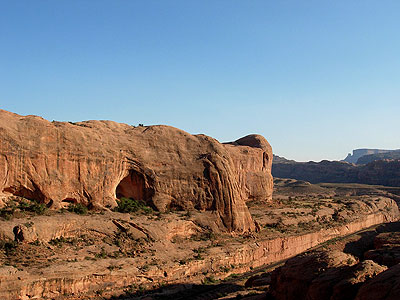
The trail then begin to cross a shallow lip between cliffs on my right and a canyon on my left. Looking back across the deep narrow canyon were the cliffs and alcoves I had seen before. I later learned this canyon was called "Bootleg Canyon". At the bottom of the Bootleg canyon ran the railroad tracks I had crossed at the start of the trail. The tracks continue up the canyon and through a one mile long tunnel until they reach Highway 191 and head toward Crescent Junction at Interstate 70. The Trains run several times a week hauling potash from the plant. Luckily for me, they weren't running that day.
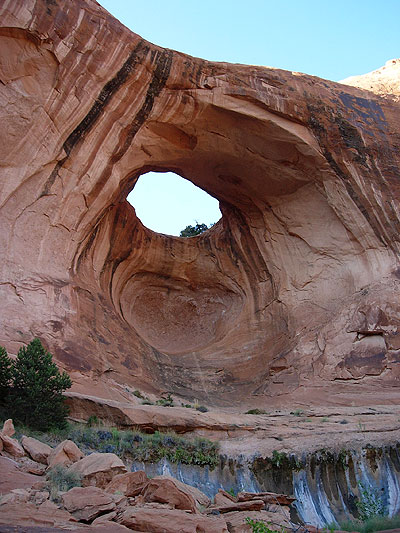
I passed Bowtie arch on the way to Corona arch. One of the fun extras of the hike.
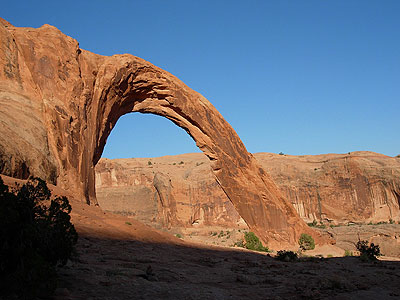
All the while I was getting closer to Corona arch, and it was getting bigger and bigger all the whole time. It was huge. Sculpted from Navajo sandstone it is also called "little rainbow arch" but it's far from little, it's opening being 140 ft by 105 ft. Rumor has it a local airplane pilot flew a small plane through it! Corona arch is a buttress arch as one end is set in the cliff face. It is one of the biggest arches I've ever seen as I climbed underneath it to get to the other side. I wanted to find out if the arch lived up to it's name.
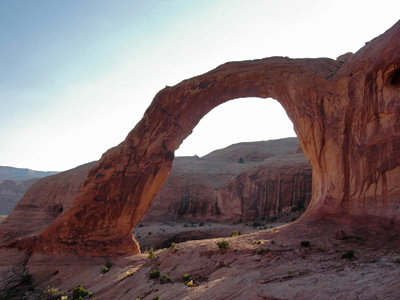
Once I got far enough past it to be able to get the whole arch in a photo I turned around and was stunned by the beauty. The setting sun cast a glow of radiant light around the arch like a halo and the world seemed to enter a dimension of timelessness. Except for the far off cries of the local ravens there was only the silence of the breeze and lengthening shadows to keep me company. The arch stood passive. Unmoved by anything but time measured in millenniums.
After the sun had dropped below the cliffs I headed back to my truck in order not be be caught in the dark. On the way back I passed a couple hiking in with their dog, a chocolate lab. They were the only people I saw the whole hike. How that dog climbed the metal ladder I'll never know.
When I got back to LA I pasted six images together to create a panorama of Bootleg Canyon with Corona arch on the left.

Click on the image to see it full size.
July 2, 2005. Day 12
Every so often, when I'm out touring, I get the urge to go play. This only happens about ten times a day. I rarely act on this because my schedule is so tight and I'm not supposed to be driving around putting hundreds of miles on my truck to go play -I'm supposed to be working. Once in a while though, I give in to these urges and I take off a little early from an appearance and head for a wild spot where there is more nature and less human.

Last June, while in Moab, I did just that. I packed up my flutes and headed north out of town. Just after crossing the Colorado river I turned left onto Potash road.
Potash road.

Potash road runs along the north side of the Colorado and passes some very nice petroglyph panels. They're right by the road. So close that if you get out to look at them you have to keep an eye out for cars driving by.

A little farther down from the petroglyph there are some dinosaur footprints. I'd say this guy wore a size 50 shoe.
A couple miles down the road there was a small dirt parking lot and a sign marking the trail head to Corona Arch. I had overheard some people in town saying how nice the arch was, but I wanted to see how far Potash road went, so I kept on driving. Soon, however, the paved road ended at the potash plant and became dirt. I realized that from this point on it continued into Canyonland NP and as it was about 5:00 pm I didn't have enough time for to really explore to road any further .

Before heading back I took some photos of a thin arch visible from the side of the road, when the Corona arch popped into my mind again. Ever since I had seen the trail leading off to it I couldn't get rid of the desire to hike out and see it. So when I got back to the trailhead I pulled my truck off into the parking lot, grabbed some water and my camera, and headed out.
The trail to Corona Arch

The hike started up a little hill and at the top, I was surprised to find the trail crossing some railroad tracks! The tracks, it turns out, were there for trains that haul potash from plant I'd seen at the end of the road.


The trail continued up a small side canyon and then came out on a flat area covered with small scrub and a dusty trail. I was completely alone. The trail crested a shallow rise and in the distance some cliffs with large alcoves came into view. For a while the trail kept heading toward them but soon it begin to curve off to the left, where after rounding a bend, I caught my first glimpse of Corona arch about a half mile up a canyon.

Even at that distance the arch looked huge, as big as any arch I'd ever seen. Picking up my pace I hoped to get up to it before the sun set behind the cliffs. The trail got rougher as it came upon some small ledges that were not passable without rock climbing gear. Luckily someone (the BLM) had run a chain-link hand rail attached to some posts sunk into the stone to aid the average hiker like me scale the rocks. Farther on there was a metal ladder for an even stepper ledge.


The trail then begin to cross a shallow lip between cliffs on my right and a canyon on my left. Looking back across the deep narrow canyon were the cliffs and alcoves I had seen before. I later learned this canyon was called "Bootleg Canyon". At the bottom of the Bootleg canyon ran the railroad tracks I had crossed at the start of the trail. The tracks continue up the canyon and through a one mile long tunnel until they reach Highway 191 and head toward Crescent Junction at Interstate 70. The Trains run several times a week hauling potash from the plant. Luckily for me, they weren't running that day.

I passed Bowtie arch on the way to Corona arch. One of the fun extras of the hike.

All the while I was getting closer to Corona arch, and it was getting bigger and bigger all the whole time. It was huge. Sculpted from Navajo sandstone it is also called "little rainbow arch" but it's far from little, it's opening being 140 ft by 105 ft. Rumor has it a local airplane pilot flew a small plane through it! Corona arch is a buttress arch as one end is set in the cliff face. It is one of the biggest arches I've ever seen as I climbed underneath it to get to the other side. I wanted to find out if the arch lived up to it's name.

Once I got far enough past it to be able to get the whole arch in a photo I turned around and was stunned by the beauty. The setting sun cast a glow of radiant light around the arch like a halo and the world seemed to enter a dimension of timelessness. Except for the far off cries of the local ravens there was only the silence of the breeze and lengthening shadows to keep me company. The arch stood passive. Unmoved by anything but time measured in millenniums.
After the sun had dropped below the cliffs I headed back to my truck in order not be be caught in the dark. On the way back I passed a couple hiking in with their dog, a chocolate lab. They were the only people I saw the whole hike. How that dog climbed the metal ladder I'll never know.
When I got back to LA I pasted six images together to create a panorama of Bootleg Canyon with Corona arch on the left.

Click on the image to see it full size.
Thursday, March 16, 2006
Native American Flute Part 9: Keith Stanford

Last June I gave my first Native American flute class here in southern California. People came from all over the area but one person drove all the way from Tucson, Keith Stanford. At the time I thought this was a long way to come for a flute class but I'm glad he did. Why? Well, after the class ended and I was packing up I heard my friend, Barry, playing a flute behind me. I really thought the sound was unique. It was warm and mellow, yet strong and focused. As I turned around to check out the flute, Barry pointed to Keith who was standing next to him, and announced "Keith made this flute!". I knew immediately I wanted one of his flutes.
Like many good flute makers Keith Stanford does not make flutes full time, it is his hobby, so it took a couple months to get a flute from him. But he didn't just send me one flute, he sent me three and told me to pick the one I liked the best. They were all in F and all of them had that same sound I had heard back in June. One was made of Rosewood, one of Purpleheart, and one of African Padduk. After going back and forth over which one like liked the best, I finally made my pick, the Rosewood.
The flute

This flute is 23 1/2" long with a 1" bore. The body is made of Rosewood. Rosewood is a general term and refers to many richly colored woods, mostly brown. All rosewoods are strong, being a hard wood. The most widely know is Brazilian, or Rio rosewood, that was once highly sought after for acoustic guitar construction and fret boards.
The name rosewood comes from its strong, sweet, lingering scent. Because of this in the 1920's it became one of the ingredients for Channel No. 5. The use of Rosewood in fragrances, soaps, and guitars lead to overexploitation and the wood became endangered. It is now protected by CITES (Convention on International Trade in Endangered Species of Wild Fauna and Flora) and is very carefully controlled and hard to obtain.
Other rosewoods used for musical instruments are Cocobolo, for Native American flutes, we've looked at one made by Yazzie flutes, and Honduras rosewood for Marimbas and xylophones.
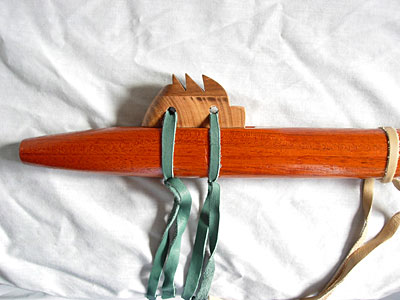
The block is in the form of an abstract Javelina and is made of two woods, Walnut on top and Hickory on the bottom.
This flute has that wonderful sound that I first heard back at my flute class.
Listen to a sample of this flute.
EARTH & SKY
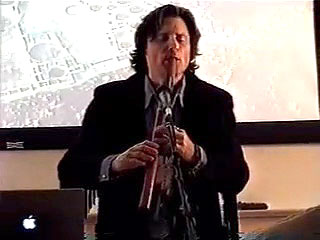
The tone of this flute is so nice I've started playing it during concerts for the song Earth & Sky, from my second CD Sacred Dreams. That version was recorded using a Woodsongs flute. In November of last year I gave a concert in Tucson, AZ and just for fun I decided to play flutes made only by Arizona makers: J.P. Gomez, Mike Gulino, Pat Haran, Richard Maynard, Keith Stanford, Ed Pendrys and others. I performed Earth & Sky on Keith's flute and the recording made of that performance came out well enough that I've posted it in both audio and video formats on cedarmesa.com. It's available to everyone on my E-mailing list. Joining the list is free and you can do it Here.
Keith's Native American flute making Manual
Although Keith doesn't make a lot of flutes as it's his hobby, he has written a book for those that do: the "Ki-e-ta Native American Style Flute Manual". This manual is very popular with beginning and more advanced flute makers. Keith is an engineer by profession and brings that detailed analyzes to his work. I have met people that use his manual who are very pleased with the results and speak very highly of it. I have also played some flutes made using the Ki-e-ta manual as a guide, and they all sounded very pleasing.



Keith says that "No prior Woodworking experience necessary and you don't need to have a lot of tools". He has also included over 40 pictures to make each step clear.
Keith lives in Tucson, and is a member of the Tucson flute circle.
To find out more information about Keith Stanford and other flute makers check out the Flute Makers page on my web site.
If you want to read more posts about other Native American flute makers visit my Blog index.
More information
For a more detail look at the construction of the Native American flute read the History and Construction article on www.cedarmesa.com.
Comments
Let me know if you enjoyed this post. Leave a comment below.
Do you have a flute by any of the Makers we have looked at so far? If so let me know what you think of it.
Scott August
Subscribe to:
Posts (Atom)
